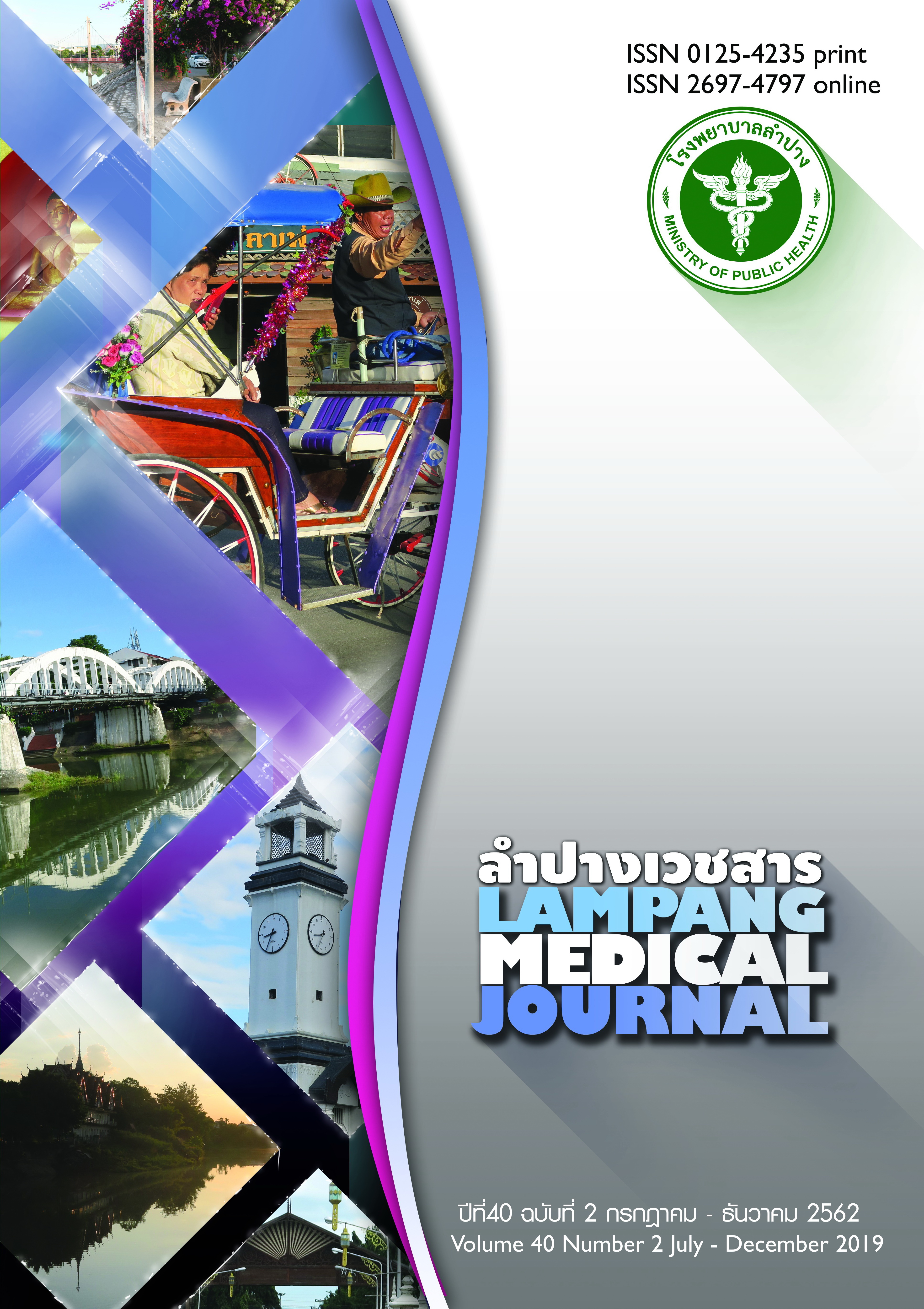The Impact of Body Mass Index on Perioperative Outcomes in Patients Undergoing Percutaneous Nephrolithotomy
Main Article Content
Abstract
Background: To date, percutaneous nephrolithotomy (PCNL) is the gold standard treatment for patients with large renal calculi (RC). Whether obesity has an adverse effect on its success remains controversial.
Objective: To compare the perioperative outcomes of PCNL among Thai individuals with various
body mass indices (BMI).
Material and method: A retrospective, cross-sectional study was conducted among 205 patients
who underwent PCNL in Ramathibodi Hospital between January 2011 and August 2019. The patients were classified into normal weight (n=98, BMI 18.5 - 24.9 kg/m2); overweight (n=76, BMI 25.0 - 29.9 kg/m2); and obese group (n=31, BMI ≥30.0 kg/m2). Perioperative outcomes were statistically compared between groups.
Abstract
Results: Stone-free status in the obese group was not different from the normal weight and overweight
group (64.5%, 58.2% and 50.0% respectively, p=0.338). There were no significant differences in blood loss (p=0.966), operative time (p=0.663), percentage change of eGFR (p=0.259), length of stay (p=0.381) and postoperative complications (p=0.435) between the three groups.
Conclusion: BMI did not affect the perioperative outcomes of PCNL. Its outcomes in obese patients
were not different from those of normal-weight patients.
Article Details
บทความที่ส่งมาลงพิมพ์ต้องไม่เคยพิมพ์หรือกำลังได้รับการพิจารณาตีพิมพ์ในวารสารอื่น เนื้อหาในบทความต้องเป็นผลงานของผู้นิพนธ์เอง ไม่ได้ลอกเลียนหรือตัดทอนจากบทความอื่น โดยไม่ได้รับอนุญาตหรือไม่ได้อ้างอิงอย่างเหมาะสม การแก้ไขหรือให้ข้อมูลเพิ่มเติมแก่กองบรรณาธิการ จะต้องเสร็จสิ้นเป็นที่เรียบร้อยก่อนจะได้รับพิจารณาตีพิมพ์ และบทความที่ตีพิมพ์แล้วเป็นสมบัติ ของลำปางเวชสาร
References
Jitnarin N, Kosulwat V, Rojroongwasinkul N, Boonpraderm A, Haddock CK, Poston WS. Prevalence of overweight and obesity in Thai population: results of the National Thai Food Consumption Survey. Eat Weight Disord. 2011;16(4):e242-9.
Asplin JR. Obesity and urolithiasis. Adv Chronic Kidney Dis. 2009;16(1):11-20.
Reinius H, Jonsson L, Gustafsson S, Sundbom M, Duvernoy O, Pelosi P, et al. Prevention of atelectasis in morbidly obese patients during general anesthesia and paralysis: a computerized tomography study. Anesthesiology. 2009;111(5):979-87.
Thelwall S, Harrington P, Sheridan E, Lamagni T. Impact of obesity on the risk of wound infection following surgery: results from a nationwide prospective multicentre cohort study in England. Clin Microbiol Infect. 2015;21(11):1008.e1-8.
Stein PD, Beemath A, Olson RE. Obesity as a risk factor in venous thromboembolism. Am J Med. 2005;118(9):978-80.
Mobley D, Baum N. The obesity epidemic and its impact on urologic care. Rev Urol. 2015;17(3):165-70.
Wiltz AL, Shikanov S, Eggener SE, Katz MH, Thong AE, Steinberg GD, et al. Robotic radical prostatectomy in overweight and obese patients: oncological and validated-functional outcomes. Urology. 2009;73(2):316-22.
Yang RM, Bellman GC. Tubeless percutaneous renal surgery in obese patients. Urology. 004;63(6):1036-40; discussion 40-1.
Ortiz CT, Martínez AIM, Morton AJV, Reyes HV, Feixas SC, Novo JFS, et al. Obesity in percutaneous nephrolithotomy. Is body mass index really important? Urology. 2014;84(3):538-43.
Isoglu CS, Suelozgen T, Boyacioglu H, Koc G. Effects of body mass index on the outcomes of percutaneous nephrolithotomy. Int Braz J Urol. 2017;43(4):698-703.
Alyami FA, Skinner TA, Norman RW. Impact of body mass index on clinical outcomes associated with percutaneous nephrolithotomy. Can Urol Assoc J. 2013;7(3-4):E197-201.
El-Assmy AM, Shokeir AA, El-Nahas AR, Shoma AM, Eraky I, El-Kenawy MR, et al. Outcome of percutaneous nephrolithotomy: effect of body mass index. Eur Urol. 2007;52(1):199-204.
Koo BC, Burtt G, Burgess NA. Percutaneous stone surgery in the obese: outcome stratified according to body mass index. BJU Int. 2004;93(9):1296-9.
Faerber GJ, Goh M. Percutaneous nephrolithotripsy in the morbidly obese patient. Tech Urol. 1997;3(2):89-95.
Fuller A, Razvi H, Denstedt JD, Nott L, Pearle M, Cauda F, et al. The CROES percutaneous nephrolithotomy global study: the influence of body mass index on outcome. J Urol. 2012;188(1):138-44.
De la Rosette JJ, Opondo D, Daels FP, Giusti G, Serrano A, Kandasami SV, et al. Categorisation of complications and validation of the Clavien score for per-cutaneous nephrolithotomy. Eur Urol 2012;62(2):246–55.17. Taylor EN, Stampfer MJ, Curhan GC. Obesity, weight gain, and the risk of kidney stones. JAMA. 2005;293(4):455-62.
Naguib MT. Kidney disease in the obese patient. South Med J. 2014;107(8):481-5.
Pigna F, Sakhaee K, Adams-Huet B, Maalouf NM. Body fat content and distribution and urinary risk factors for nephrolithiasis. Clin J Am Soc Nephrol. 2014;9(1):159-65.
Lang LH, Parekh K, Tsui BYK, Maze M. Perioperative management of the obese surgical patient. Br Med Bull. 2017;124(1):135-55.
Bagrodia A, Gupta A, Raman JD, Bensalah K, Pearle MS, Lotan Y. Impact of body mass index on cost and clinical outcomes after percutaneous nephrostolithotomy. Urology. 2008;72(4):756-60.
Zhou X, Sun X, Chen X, Gong X, Yang Y, Chen C, et al. Effect of obesity on outcomes of percutaneous nephrolithotomy in renal stone management: a systematic review and meta-analysis. Urol Int. 2017;98(4):382-90.


